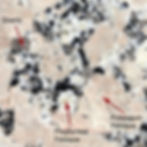For a more in-depth understanding of clay, one needs to distinguish between the natural conception of clay and the standardised clay bodies we use today in the ceramic industry and in the pottery studio.
The standardised clay body is a factory-made product formulated by a mixture of refined clays in order to commercially supply to the demands of an industrial market. Today, this is also the primary source for the modern studio potter who always works against time and budget.
The peasant or primitive potter relied on natural clay deposits and it was the ideal of the country potter to dig for a single clean clay in the vicinity of where the wood-fired kilns are set up. During early industrialisation in the West, areas rich in clay deposits were demarcated for the building of large kilns for mass production of ceramic ware. Often, after expiry, these landmarks were designated as sites for unmarked graves and mass burials. The Potter’s Field on Hart Island in New York has recently become the burial site for hundreds of unknown or unclaimed COVID-19 victims.
Clay is a product of nature and has geological origin in granite, which is an igneous rock. Granite rock forms when magma cools slowly below the earth’s surface. The slow crystallisation produces a granular texture containing, amongst other elements, feldspar and quartz. Feldspar can be recognised as the rectangular white crystal in a slab of polished granite.
Large proportions of the earth’s surface are made up of feldspathic rock formations – Feldspar, a mined mineral, is the primary ingredient of all standardised clay bodies and secondary ingredient for glaze production. The feldspar crystal contains enough alkali -a water soluble ionic salt – to cause it to melt into a semi-transparent whitish glaze at relatively lower temperatures.
Through time, the natural decomposition of granite rock formations frees the feldspar of its alkaline content resulting in kaolin, a primary clay also known as china clay. With the loss of the alkali, the resulting kaolin is invaluable to pottery because it can withstand relatively higher temperatures.
Through the process of erosion, kaolin deposits are carried away from its source by water and in the journey gathers impurities before settling as secondary clay in sedimentary beds. Secondary clays may be classed as refractory, vitrifiable, and fusible clay. Respectively, the impurities in secondary clay results in different melting points, ranging in vitrification from 1200 to 1500 degrees Celsius. In addition, impurities, such as vegetable matter or carbon, lime, iron, soda, potash, and magnesia contribute to the plasticity of respective clays.
Secondary clays were intermixed by the traditional potter in order to create a desired clay body, be that for colour, texture, building technique, wheelwork or desired melting or vitrification temperature. Due to variation in geological formations, geography often contributed to the ceramic identity of cultures from region to region. For example, clay compositions differed in early West, Near East, and Far East ceramic production resulting in respective aesthetic appreciation.
In conclusion, and in contrast to natural clay, the standardised factory-made clay we use in the studio may be seen as a modern, scientific intervention in nature. The ingredients of natural clay deposits are scientifically analysed and broken up into its mineral and chemical building blocks, for example, kaolin, talc, magnesium, silica, lime, potash, feldspar, soda, iron, zinc and so forth. These elements are then mined as pure substances and marketed as such for different industries.
Industries such as NASA (ceramic tiles were used to clad the space shuttle), IBM (computers have many ceramic components) and sanitary ware production would develop different clays to meet their respective requirements. For our art and craft industry, clay is standardised to meet a standardised glaze industry, resulting in standardised firing temperatures. In other words, as consumers, we are offered clay and glaze products that are likewise compatible to our kiln firing temperature.

Slab of polished granite



